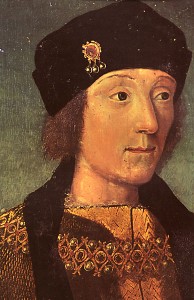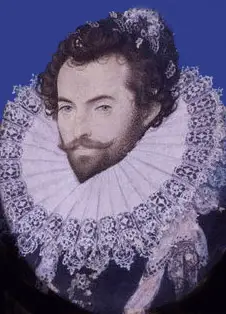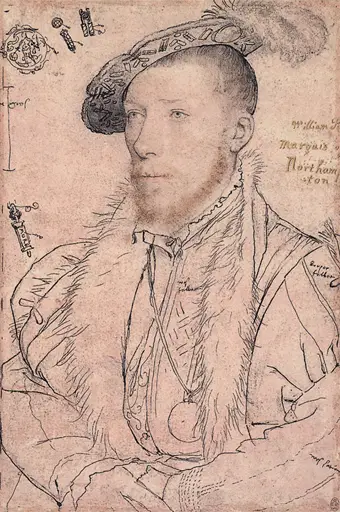Arthur's Birth
David Starkey1 writes of how the court arrived at Winchester in early September and wonders if it was the 60+ mile journey on bad roads that caused Elizabeth to go into labour and give birth a month early. Arthur was born "afore one o'clock after midnight"2 on 20th September 1486 and despite being about a month premature, little Arthur was healthy. His mother did go on to suffer with some type of fever, but fortunately survived.
The birth of the heir to the throne was celebrated with bonfires in the streets and the singing of the Te Deum at Winchester Cathedral. Arrangements for the lavish christening had already been put in place but now needed bringing forward a month. However, Starkey writes of how Arthur's intended godfather, John de Vere, 13th Earl of Oxford, was still at home at Lavenham in Suffolk and needed to travel from there to Winchester, so the christening could not take place straight away. The date was set for Sunday 24th September.
Arthur's Christening
David Starkey3 tells the story of Arthur's christening, writing that those taking part in the procession gathered in the Queen's apartments, while others like Elizabeth Woodville, Athur's godmother and grandmother (also Queen Dowager), waited at the cathedral. After waiting three hours for the Earl of Oxford to arrive, Henry VII ordered that the ceremony should go ahead with Thomas Stanley, the Earl of Derby and the King's stepfather, standing in for Oxford. The baby prince was named "Arthur" and baptised and then Oxford arrived and cradled Arthur in his right arm, presenting him for his Confirmation. The party then processed to the shrine of St Swithun, the cathedral's saint, where hymns were sung. Starkey writes of how the adults then enjoyed "spices and hypocras, with other sweet wines [in] great plenty" while Lady Cecily, Arthur's aunt, took Arthur home, processing past burning torches, through the royal nursery, to the sound of musicians playing, and to his parents.Starkey points out that the christening of Prince Arthur "was the first of many spectacular ceremonies that Henry used to mark each stage of the advance and consolidation of the Tudor dynasty"4, it was the start of a whole new era.
Click here to view a Claire Chats video on ordinances written by Margaret Beaufort, Henry VII's mother, in 1486 when Elizabeth of York was pregnant with Arthur. The ordinances included instructions on how to prepare the birthing chamber and royal nursery, and instructions for the christening.
Upbringing
The royal nursery was managed by Elizabeth, Lady Darcy, and Arthur was given a wet-nurse, a lady named Caroline Gibbons. Two royal "rockers" were also appointed to rock the baby prince's cradle and two men, John Alc*ck, Bishop of Worcester, and Peter Courtenay, Bishop of Exeter, advised the King on Arthur's upbringing.
On the 29th November 1489, Arthur was made a Knight of the Bath and on the 30th November was created Prince of Wales. On that same day, his baby sister, who had been born the night before, was baptised and named Margaret, after her grandmother and godmother, Lady Margaret Beaufort. Arthur's brother, the future Henry VIII was born on the 28th June 1491 and his sister, Mary, was born on the 18th March 1496. Three other siblings - Elizabeth, Edmund and Katherine did not survive childhood, with Katherine dying on the day of her birth.
Arthur, Prince of Wales, was educated by scholar John Rede, French poet Bernard André and later Thomas Linacre, the English Humanist and physician who also educated Erasmus. In 1492, he was sent to Ludlow Castle in the Welsh Marches to begin his education as the future king. David Starkey writes of "Arthur's driven, solitary childhood" and how the result was "a model prince" who "displayed the exaggerated sense of responsibility of the eldest child". He was also "intellectually precocious" and had a rather stiff public manner. 5
Marriage
Starkey writes of how marriage negotiations for Arthur began when he was aged two, when he was contracted to marry Catherine of Aragon, the daughter of Ferdinand and Isabella of Spain, in the 1489 Treaty of Medina del Campo. Twelve years later, in the autumn of 1501, Catherine of Aragon landed in England and the couple met at Dogmersfield in Hampshire.Arthur, Prince of Wales, married Catherine of Aragon on Sunday 14th November 1501 at St Paul's Cathedral in another Tudor lavish ceremony. Arthur's younger brother Henry, the man who Catherine later married, escorted the bride from the bishop's palace to the cathedral. They processed into the cathedral on an elevated platform which ran the whole length of the nave and which allowed the bride to get through the overly crowded cathedral. The marriage ceremony then took place on a tall, tiered platform in the centre of the nave.
We don't know exactly what happened after the traditional bedding ceremony, but Arthur boasted the next morning "bring me a cup of ale for I have been this night in the midst of Spain!" Later, when her second husband sought to annul their marriage on the grounds that Catherine was his brother's widow and that the union was therefore incestuous, Catherine claimed that her marriage to Arthur had never been consummated.
Arthur's Death
Just before Christmas 1501, the couple left the royal court at Richmond to travel to Ludlow, stopping to celebrate Christmas at Woodstock in Oxfordshire. The plan was for Arthur and Catherine to get experience in government by governing the Welsh Marches, but things were not to be. On the 2nd April 1502, Arthur died. It is not known what exactly killed him but theories include sweating sickness and consumption (tuberculosis). Catherine also became ill but recovered, although she missed her husband's funeral at Worcester Cathedral, as did his father but then this could have been for fear of catching the plague in "plague-ridden Worcester"6. Arthur's resting place and memorial, Prince Arthur's Chantry, can still be seen today at the Cathedral.
Instead of a second King Arthur setting up a new Camelot and heralding in a golden age, the throne passed from Arthur's father, Henry VII, to Arthur's younger brother who became King Henry VIII, and it is Elizabeth I, Henry VIII's second daughter, who is known for her Golden Age. Arthur's widow went on to marry his younger brother and tried her utmost to provide him with a much-needed Tudor male heir. She succeeded in giving him a daughter, Mary, the future Mary I, but this was not enough, and Henry VIII got their marriage annulled so that he could marry Anne Boleyn. Catherine ended her days in the remote Kimbolton Castle, where she was forbidden to see her beloved daughter, Mary, and she died there on the 7th January 1536. She was laid to rest at Peterborough Abbey, now Peterborough Cathedral, as the Dowager Princess of Wales, not Queen, on the 29th January.
Notes and Sources
- From Margaret Beaufort's Book of Hours, quoted in Henry VIII: Virtuous Prince, David Starkey, p42
- Virtuous Prince, p42-43
- Ibid., p43-45
- Ibid., p45
- Ibid., p135
- Ibid., p165






I don’t know much about Arthur and I enjoyed the article above . If possible I would like to know more about him
Thank you! His story always makes me wonder “what if?”.
In the article of Prince Arthur, I noted Henry VII decided to have Thomas Stanley begin the service. Your article says he was Earl of Derby. Can you give information as to which Thomas Stanley it was? I have three in my ancestry, but I do not know which one was the step father of Prince Arthur. Please let me know when you can.
This was the Thomas Stanley, who was made Earl of Derby as the First Earl as a reward for his and his brother changing sides at the last moment at Bosworth. He was at that time married to his second wife, Margaret Beaufort, mother of Henry Tudor. His brother actually saved Henry at Bosworth and his horse surrounding Richard were responsible for his death and those who remained at the King’s side. Together with the Welsh that Henry brought with him, they rode into the King’s men now on foot and Richard was killed. Sir William Stanley was later executed for treason by Henry Vii as he was reported as saying that he could not support Henry against Richard of England or Perkin Warbeck as history calls him, in case he really was the son of Edward iv. This Thomas Stanley remained in the service of Henry Vii until his death in 1502/3. His son by his first wife, Eleanor, succeeded as the second Earl of Derby. He is buried with his first wife in the Parish Church in Oldham in Lancashire. Margaret was buried in Westminster Abbey after she died in 1509 as the mother and grandmother of the first two Tudor Kings, but there is an effigy in the Church at Oldham.
How did Arthur and Henry VIII get on as brothers’, were they close confidants and friends. I would like to think they got on together as close kin? More information about their early years as children would be great. I have always been interested in Tudor history, but never read anything about how all the siblings, especially Arthur and Henry got along. It can tell a lot about their characters knowing this?
They really wouldn’t have spent any time together as Arthur was educated by himself to be a future king, while Henry was educated with his sisters until after Arthur’s death.